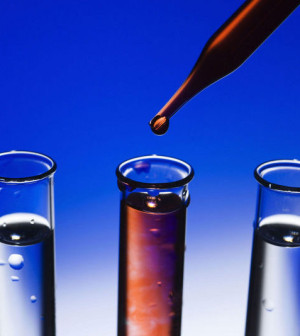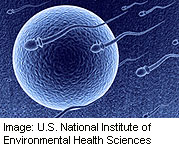- Fragments of Bird Flu Virus Found in U.S. Milk Supply
- There’s an ‘Epidemic’ of Loneliness Among U.S. Parents, Poll Finds
- Infertility Is Rising Among Young Married Women
- New Rules Mean 3.6 Million Americans Could Get Wegovy Via Medicare, Costing Billions
- ‘Dream It, Be It?’ Study Finds Teens Who Focus on Life Goals Often Succeed
- Trying ‘Magic Mushroom’ Drug to Ease Depression? It Has Side Effects
- $282 Billion: What Mental Illness Costs America Each Year
- Black, Hispanic Americans Getting Savvier About CPR
- Kids With Common Skin Conditions Face Stigma, Bullying
- Science Reveals How Aspirin Prevents Colon Cancer
FDA Explores ‘3-Person’ Embryo Fertilization


U.S. Food and Drug Administration hearings opened Tuesday on a controversial fertilization technique that uses the DNA from three people — two women and one man — with the goal of preventing inherited genetic diseases.
The technique involves the unfertilized eggs, or “oocytes,” from two females. Parts of each egg are combined to weed out inherited genetic disorders contained in one woman’s DNA, and the resulting healthy egg is then fertilized using a male’s sperm.
The FDA’s two-day hearing is meant to provide a forum for discussing how this technique might be tested in human clinical trials.
But the discussion is expected to veer into the ethics of manipulating human genetics to produce “perfect” babies.
“The potential benefits are huge, but the potential harms are also huge,” said Dr. Michelle Huckaby Lewis, a faculty member at the Johns Hopkins Berman Institute of Bioethics and the Genetics and Public Policy Center, in Washington, D.C.
The procedure could have unintended health consequences both for newborns and for future generations, as the genetic tinkering reverberates through time, Lewis said.
In addition, she said, the technique raises troubling questions of parental rights and family structure.
“When you use a technology in a new way like this, it really challenges our notions of what it means to be a parent and what it means to be a family,” Lewis said.
The hearing was prompted by the work of Shoukhrat Mitalipov, an associate scientist at Oregon Health & Science University (OHSU).
Mitalipov has used the fertilization technique to produce five healthy monkeys, and is seeking FDA approval to begin human trials involving women who carry defective genes that could pass on severe illnesses to their children.
He is on hand at the hearing to explain the process, which he described Monday to the Associated Press as “gene correction” rather than “gene modification.”
“We want to replace these mutated genes, which by nature have become pathogenic to humans,” Mitalipov told the AP. “We’re reversing them back to normal, so I don’t understand why you would be opposing that.”
The procedure is aimed at preventing illness caused by defective DNA in a mother’s mitochondria, the tiny structures that produce energy to power individual cells.
During reproduction, an embryo inherits nearly all the maternal mitochondria present in the egg. That means any genetic mutations present in the mitochondria will be passed on from mother to child, according to the OHSU website.
About one in every 5,000 American children inherits genetic illnesses from their mother’s mitochondrial DNA. These diseases can lead to health problems as far-ranging as blindness, organ failure, epilepsy, cancer and diabetes, the OHSU noted.
The new technique seeks to avoid this by using an egg from a healthy female donor that contains undamaged mitochondria. The nucleus DNA of the prospective mother is implanted into the donated egg, replacing the nucleus DNA of the donor.
The result: a child who inherits the mother’s nucleus DNA, which contains most of a person’s inherited traits, but the donor’s healthy mitochondrial DNA. The child could have the mother’s eye color or height, but would not run the risk of inheriting a genetic disease from the mitochondria.
Such genetic tinkering raises concerns among many bioethicists. In a letter to the FDA, the nonprofit Center for Genetics and Society noted that “more than 40 countries, including those with the most highly developed biomedical sectors, have adopted policies on human germ-line modification, and all of these have prohibited it.”
“This emerging global policy consensus has been supported by the major international biomedical and bioethical organizations and councils,” the letter continued. “We believe that it would be unconscionable for the United States to unilaterally cross this bright technical and policy line that has been observed internationally for decades.”
The center’s letter also questioned how useful the new procedure would be.
“We sympathize with women who place a high importance on having children genetically related to them. But we note that the number of women who would be candidates for the techniques in question is quite small,” the letter stated. “While about one in 5,000 to 10,000 people suffer from mitochondrial diseases, only about 15 percent of mitochondrial disease is caused solely by mitochondrial DNA mutations,” the letter said.
For her part, Lewis said the FDA first must determine how safe these procedures are, and how to ensure safety during human trials.
Beyond that, the agency will need to weigh how to track children born from this process, so any unintended consequences — for example, new birth defects that crop up from genetic manipulation — can be detected, she said.
“There has not been a registry to follow these children who were created through the use of in vitro fertilization and other artificial techniques, so maybe that is something to think of going forward,” Lewis said.
The process also raises a number of societal concerns regarding parental rights and consent.
“It will be important to emphasize what the consent form looks like so it’s very clear what the potential future rights of all the different people are,” she said. “As experience has shown, these sort of problems arose that weren’t contemplated when IVF was first discovered.”
More information
For more about three-person embryo fertilization research, visit Oregon Health & Science University.
Source: HealthDay
Copyright © 2024 HealthDay. All rights reserved.










